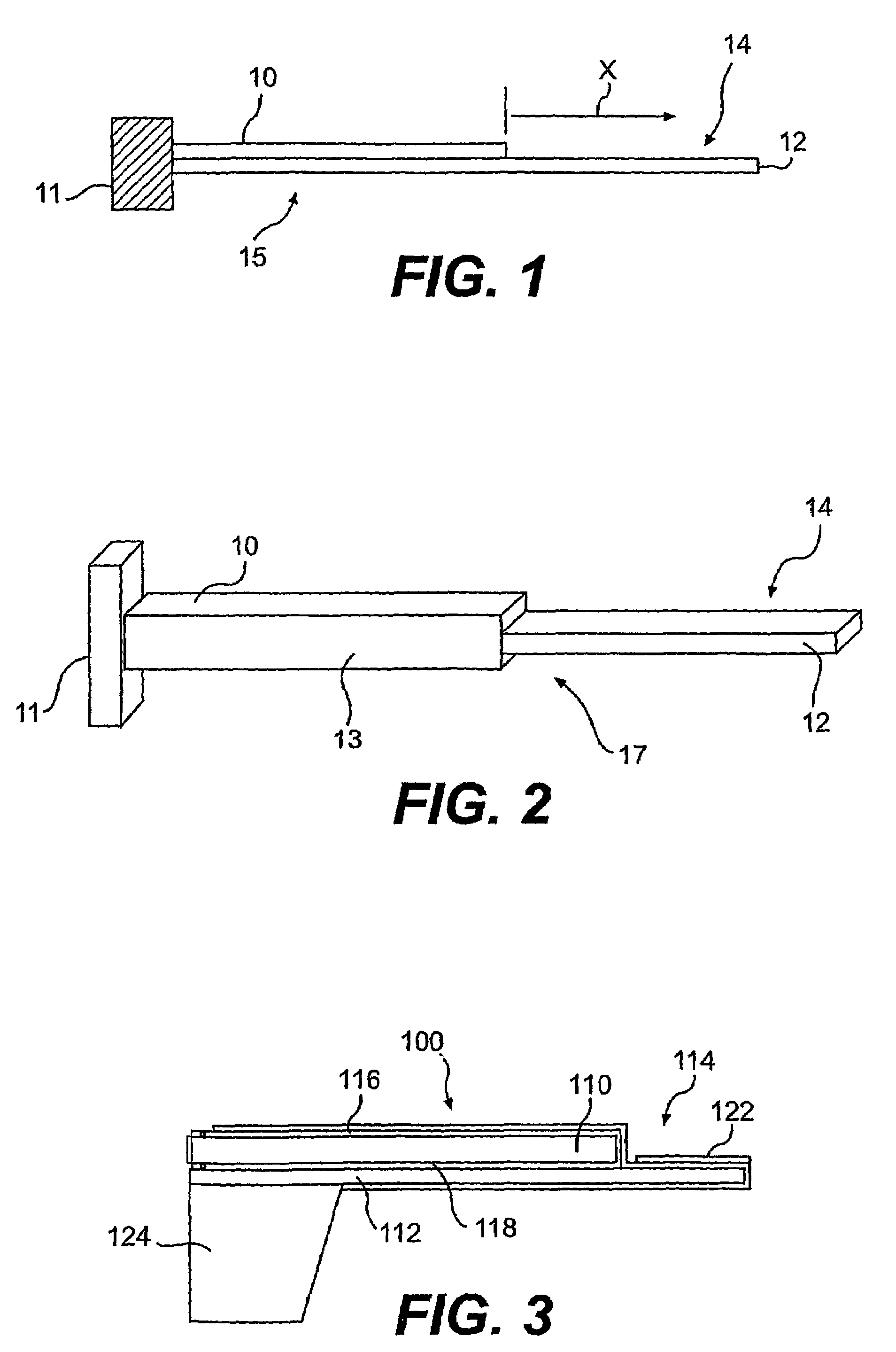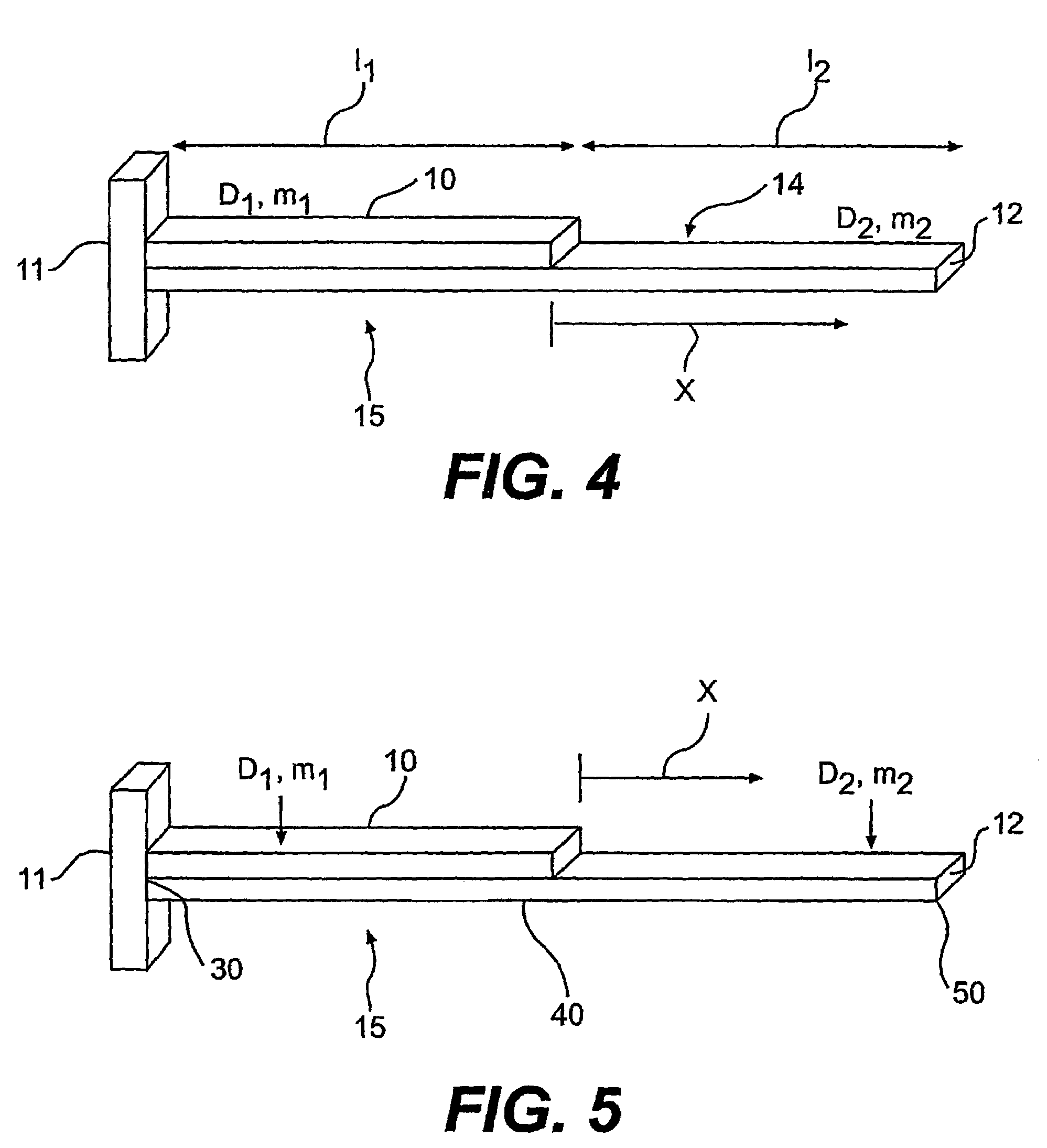Piezoelectric cantilever sensors
a technology of piezoelectric and cantilever sensors, applied in the field of sensors, can solve the problems of not being able to measure the change in mass, many of these techniques are not direct, nor quantitative, and many of them are also quite slow
- Summary
- Abstract
- Description
- Claims
- Application Information
AI Technical Summary
Benefits of technology
Problems solved by technology
Method used
Image
Examples
example 1
[0056]FIGS. 4-8f show various graphs that demonstrate the performance of PECS 15, and the effects of variations in the length of non-piezoelectric tip 14. PECS 15 detects mass changes by electrically monitoring resonance frequency shifts in flexural modes. The measured resonance frequencies range from 500 kHz to 1500 kHz, or from 1 kHz to 1000 kHz.
[0057]FIG. 4 shows a diagram of PECS 15 illustrating the parameters used in determining the geometry of PECS 15. The equation
[0058]Diⅆ4hi(x,t)ⅆx4+miⅆ2hi(x,t)ⅆt2=0,i=1,or2
governs the waveform for of PECS 15. The equation:
h1(x)=C11 sin(k1x)+C12 cos(k1x)+C13 sin h(k1x)+C14 cos h(k1x)
governs that portion of PECS 15 that extends for length l1 and contains both piezoelectric layer 10 and non-piezoelectric layer 12, while the equation:
h2(x)=C21 sin(k2x)+C22 cos(k2x)+C23 sin h(k2x)+C24 cos h(k2x)
governs that portion of non-piezoelectric layer 12 that begins at the end of l1 and extends the length of l2.
[0059]FIG. 5 shows the equations go...
example 2
[0076]This example shows the behavior of PECS 15 in three viscous solutions labeled as samples 1-3 in FIG. 9, as well as in air and water. This example demonstrates that the viscosity of the fluid in which PECS 15 is immersed, does not dramatically affect the resonance frequency. Therefore, PECS 15 will be useful for detection in viscous solutions. Furthermore, the ability to predict the behavior of the PECS 15 in various viscosities based upon the known geometry of PECS 15 permits the use of PECS 15 to measure the viscosity of a fluid. The viscosity of the three samples was measured by a rheometer. The viscosity of water and the three samples are, shown below in Table 1.
[0077]
TABLE 1Viscosity(cp)Δf (Hz)Q valueΔf / fair(%)Water114017.510.1Sample 124918011.613Sample 29952307.417Sample 337002805.620.3
[0078]Q=f / δf, with f representing the resonance frequency, and δf representing the width of the resonance peak at half the peak height. A higher Q value indicates a better signal intensity....
PUM
 Login to View More
Login to View More Abstract
Description
Claims
Application Information
 Login to View More
Login to View More - R&D
- Intellectual Property
- Life Sciences
- Materials
- Tech Scout
- Unparalleled Data Quality
- Higher Quality Content
- 60% Fewer Hallucinations
Browse by: Latest US Patents, China's latest patents, Technical Efficacy Thesaurus, Application Domain, Technology Topic, Popular Technical Reports.
© 2025 PatSnap. All rights reserved.Legal|Privacy policy|Modern Slavery Act Transparency Statement|Sitemap|About US| Contact US: help@patsnap.com



